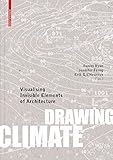Drawing Climate : Visualising Invisible Elements of Architecture / ed. by Daniel Ryan, Jennifer Ferng, Erik L'Heureux.
Material type: TextPublisher: Basel : Birkhäuser, [2021]Copyright date: ©2021Description: 1 online resource (232 p.)Content type:
TextPublisher: Basel : Birkhäuser, [2021]Copyright date: ©2021Description: 1 online resource (232 p.)Content type: - 9783035623604
- 9783035623611
- 720.47 23/eng/20230203
- NA2541
- online - DeGruyter
- Issued also in print.
| Item type | Current library | Call number | URL | Status | Notes | Barcode | |
|---|---|---|---|---|---|---|---|
 eBook
eBook
|
Biblioteca "Angelicum" Pont. Univ. S.Tommaso d'Aquino Nuvola online | online - DeGruyter (Browse shelf(Opens below)) | Online access | Not for loan (Accesso limitato) | Accesso per gli utenti autorizzati / Access for authorized users | (dgr)9783035623611 |
Frontmatter -- Contents -- Introduction: redirecting the arrows of climatic design -- Particles to dust storms: seeing climates from below -- Wind, making the invisible visible: design for and with natural ventilation -- Weathering the monsoon: affective relations -- Clouding architecture -- 90 % chance of rain: downpour as event -- Casting shadows and seeking shade -- From crystal to cryosphere: architecture for the future ice age -- Revealing fire -- Explorations: climatic design in the design studio -- About the editors and authors -- Acknowledgements -- Illustration credits -- Name index -- Subject index
restricted access online access with authorization star
http://purl.org/coar/access_right/c_16ec
Ephemeral phenomena like fire, precipitation, shade, and wind have emerged as important contemporary protagonists for environmental design due to their dynamic impact on buildings and cities. The importance of including these forces in architecture has gained rapid momentum in the global quest for sustainability. This book investigates the history, theory and applications of climatic design in the built environment examining architecture and landscapes from various time periods. Based on a collaboration between the University of Sydney and the National University of Singapore, the book brings together contributing authors from Australia, Singapore, and the United States. "Dry", "Wet", "Cool" and "Hot" divide the book into categories through which a wide array of representational topics are covered —from dust storms and clouds, to ice and bushfires. A concluding section presents project examples for exploratory application in the design of architecture.
Für das umweltbezogene, nachhaltige Entwerfen sind sich stetig ändernde Naturkräfte wie Niederschlag und Feuer, Schatten und Wind zu wichtigen Faktoren geworden. Dieses Buch geht mit Beispielen aus Architektur und Landschaft der Geschichte, den Theorien und Anwendungen der klimagerecht gebauten Umwelt nach. Es wurde in Zusammenarbeit zwischen der University of Sydney und der National University of Singapore entwickelt und von Autoren aus Australien, Singapur und den USA verfasst. Im Rahmen der Kategorien "Trocken", "Feucht", "Kühl" and "Heiß" werden Darstellungspraktiken, -methoden und -beispiele in einer weiten Spanne thematisiert: von Wolken und Sturm bis hin zu Feuer und Eis. Ein abschließender Teil zeigt Anwendungsbeispiele in experimentellen Projektentwürfen.
Issued also in print.
Mode of access: Internet via World Wide Web.
In English.
Description based on online resource; title from PDF title page (publisher's Web site, viewed 02. Mai 2023)


